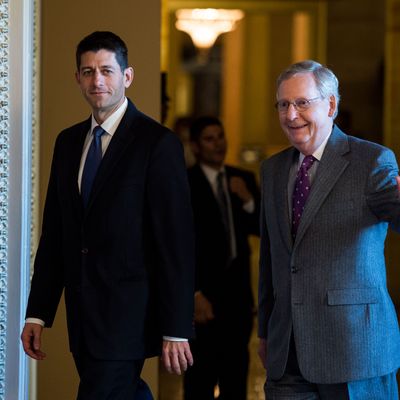
Even as they look at the wreckage of their health-care drive, and try to pivot to tax cuts, congressional Republicans have a more immediate problem: raising the public debt limit. The Treasury Department is now signaling it needs to happen by the end of September to avoid serious financial and economic consequences.
A debt-limit increase can’t be bundled into a filibuster-proof budget bill. So it will require Democratic support to get through the Senate. The need for bipartisanship is significantly increased by the fact that many House Republicans — either as a matter of conservative ideology or because of demagogic campaign trail promises, or both — simply cannot be persuaded to vote for any debt-limit increase, while others have long insisted on massive, politically impossible cuts in federal domestic spending as the price for their vote.
So getting a debt-limit increase through Congress is a game that requires considerable dexterity from a GOP House and Senate leadership that does not have an exactly sterling record of successful maneuvering this year. Everyone more or less agrees in principle that a “clean” debt-limit bill — one unencumbered with policy riders or additional provisions affecting spending or revenues — is the only thing that can attract enough Democratic votes to get through both chambers. Even House Freedom Caucus leader Mark Meadows has acknowledged that his group’s long-standing demands to attach deep spending cuts to debt-limit increases may have to be put aside to avoid a possible debt default.
But votes for a clean debt-limit bill may come with some extraneous conditions, and that’s where the wheeling and dealing could get complicated. In the recent past, Democrats have talked about making their debt-limit votes conditional on the GOP showing restraint with future tax cuts. And conservatives are eyeing the same legislation in hopes of securing the spending cuts that have eluded them in other measures. So a clean debt-limit bill could be quietly encumbered.
Another complication is made obvious by a calendar coincidence: The end-of-September deadline for passing a debt-limit increase coincides with the end of the fiscal year and the customary fight over continuing funding for federal programs. As has so often become the case, it is unlikely any regular appropriations bill will have been passed by both Houses by September 30, so we’re probably looking at either a short-term “continuing resolution” to give Congress more time to wrangle over appropriations, or a giant omnibus spending bill that accommodates demands from both parties (again, appropriations bills require 60 Senate votes, making some bipartisanship essential).
With issues ranging from conservative demands for border-wall money and the defunding of Planned Parenthood to liberal demands for Obamacare market-stabilization hanging fire, a government-shutdown crisis is entirely possible. Inevitably there will be pressure to attach spending measures to the “must-pass” debt-limit increase, which could imperil its prospects.
All in all, no one should feel too sure that threats to the full faith and credit of the United States will be met by a steely bipartisan sense of responsibility. It’s going to get crazy in Congress toward the end of September.






























